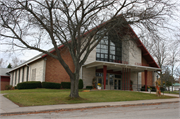Property Record
811 W JUNIPER ST
Architecture and History Inventory
| Historic Name: | Corpus Christi Catholic Church |
|---|---|
| Other Name: | |
| Contributing: | |
| Reference Number: | 229734 |
| Location (Address): | 811 W JUNIPER ST |
|---|---|
| County: | Door |
| City: | Sturgeon Bay |
| Township/Village: | |
| Unincorporated Community: | |
| Town: | |
| Range: | |
| Direction: | |
| Section: | |
| Quarter Section: | |
| Quarter/Quarter Section: |
| Year Built: | 1963 |
|---|---|
| Additions: | |
| Survey Date: | 2014 |
| Historic Use: | church |
| Architectural Style: | Contemporary |
| Structural System: | |
| Wall Material: | Stone Veneer |
| Architect: | Robert W. Surplice |
| Other Buildings On Site: | |
| Demolished?: | No |
| Demolished Date: |
| National/State Register Listing Name: | Not listed |
|---|---|
| National Register Listing Date: | |
| State Register Listing Date: |
| Additional Information: | 2015- This property, which is bounded by N. Duluth Avenue/CTH C on the west (See aerial map attachment), is home to the Corpus Christi Catholic Church Complex. Although originally built as free-standing structures, the church (1963; AHI#229734), school (1951; 1999; AHI#229736) and social hall (1963) are now all connected via “hyphen-like” connecting hallways. The convent (1963; AHI#229735) and rectory (1996; not surveyed) are located a short distance to the southwest and southeast, respectively. A bell tower structure, with the bell from the previous 1905 church, is sited just east of the church entrance, while signage with a gabled “roof” stands to the northwest. Finally, a small gabled garage (not surveyed) for storage of maintenance and grounds equipment is located closest to N. Duluth Avenue, along the south edge of the west parking lot. The primary surveyable entity of the property is the Contemporary-style church, which is located beyond a large, paved parking lot and oriented to W. Juniper Street. This religious structure is topped with a low-pitched, gabled roofline with overhanging eaves and exposed, decorative brackets. Two sets of glass doors topped by a glass transom are sheltered by a flat-roofed overhang with inverted, tapered supports and a series of four central metal posts. An expanse of glass is located above the entry and which extends to the gabled peak. Vertical sections of stone veneer frame the glass entry and windowed area, as well as cover the building’s side walls, while the remainder of the entrance façade is sheathed with brick and includes a zig-zag pattern to the east and west. Side wall windows include a series of three, three-light windows within the entry, while five larger openings punctuate the nave. A small, shed-roofed side entry extends to the west. In 2003, the original windows of the church proper were removed and replaced with re-sized, stained-glass examples from the former S. S. Cyril & Methodius Church in the Town of Eaton, Brown County. Of note, the interior of the church was designed to include seventeen wood carvings executed by woodcarver Ernest Dombrowe, including a nearly 6-foot tall figure of Christ. A gabled and brick-sheathed hyphen connects to the gabled, one-story, social hall. When built, the W. Juniper Street elevation was comprised largely of windows that surrounded a stone section that included the building name, “Corpus Christ Social Hall.” The windows have since been removed (or covered) with brick and now the wall is entirely without fenestration. Moving east and beyond another gabled hallway is the T-shaped and gabled school building. The north-south portion is the original brick, stone and board-sheathed, school structure, while the eastward-extending wing was completed in 1999. The two-story, gabled, stone and board-sheathed former convent building includes largely regularly placed, replacement windows. Until 1904-05 and the establishment of Corpus Christi Parish, Sturgeon Bay’s west side Catholics attended St. Joseph’s church on the east side. In 1905, a church and rectory were built on W. Maple Street, along the south edge of the current church parcel. In 1907, a school was established in the church basement and the original convent was erected in 1915. By 1945, the basement school was overflowing and a new school building opened in 1951; all classrooms were completed and in use by 1958. By that time, additional quarters were needed for the sisters and the congregation had outgrown the church. On 12 May 1963, a new social hall, convent and church (designed by Robert W. Surplice of Green Bay) were dedicated (all of which remain extant). In 1996, a new rectory was built and three years later, an addition to the school was completed. In 2007, the Catholic schools of Corpus Christi, St. Joseph and S. S. Peter & Paul voted to consolidate and the former Corpus Christi school was re-named St. John Bosco and opened in Fall 2007 with 158 students from 4K to 8th grade. -"CTH C/Duluth Avenue Survey," WisDOT ID #4997-00-63, Prepared by Heritage Research, Ltd. (Schnell) (2015). |
|---|---|
| Bibliographic References: | Hjalmar Rued Holand, History of Door County Wisconsin: The County Beautiful, 2 vols. (Chicago: The S. J. Clarke Publishing Company, 1917), 2:213-214; “Church of the Blessed Sacrament—Corpus Christi”; School consolidation information from the St. John Bosco Catholic School website, Available online at www.johnboscoschool.org/page/2458, Accessed January 2015. Although not confirmed, it is likely that Surplice was responsible for the designs of the other structures on the property. Indeed, the original design of the social hall, with its curtain wall (that has since been bricked over), is similar to the design of Holy Rosary Roman Catholic Church in New Holstein. |
| Wisconsin Architecture and History Inventory, State Historic Preservation Office, Wisconsin Historical Society, Madison, Wisconsin |

